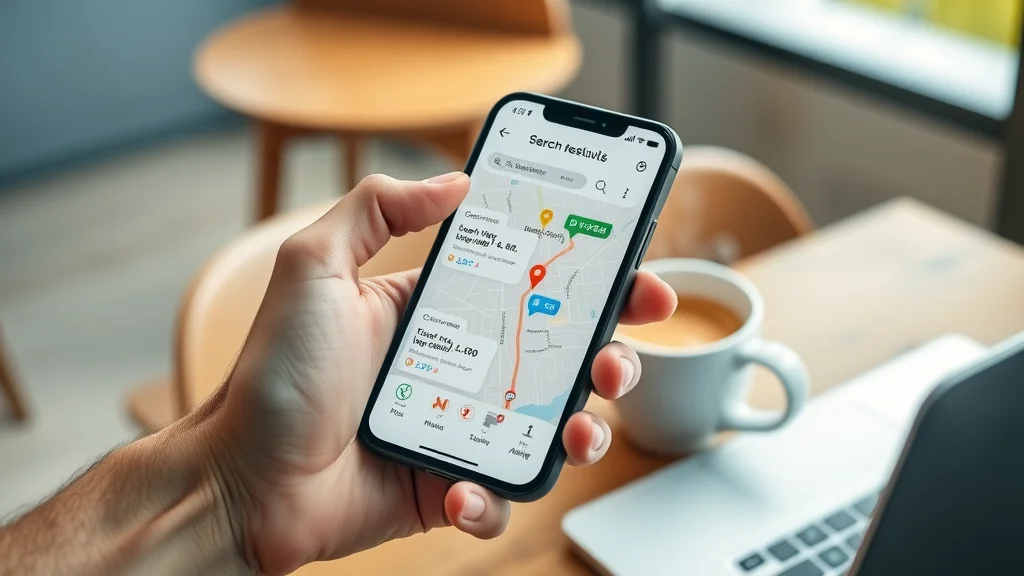Did you know that over 75% of mobile local searches lead to an in-store visit within 24 hours? This surprising statistic reveals just how powerful mobile local SEO has become for small businesses. Whether you’re a bakery on Main Street or a boutique downtown, mastering mobile local SEO isn’t a luxury—it's a must if you want to attract customers who are eager to visit or call right now. In this comprehensive guide, you’ll learn how to optimize your local business so you can show up exactly when potential customers are searching on their smartphones or tablets. Get ready to turn on-the-go searchers into loyal customers!
A Surprising Statistic: Why Mobile Local SEO Matters Now More Than Ever
Mobile local SEO is more than just a buzzword—it's an essential strategy for every small business aiming to be found by nearby customers. Today, nearly 80% of local searches are performed on mobile devices, according to Google. These mobile users expect fast, relevant results when searching for "coffee shop near me" or "best pizza nearby," and they are often only steps away from making a purchase. As the habits of consumers shift more and more toward using their phones for local search, the stakes are higher than ever for local businesses.
Failing to invest in mobile local SEO can mean missed opportunities and lost sales, especially when your competitors are already leveraging these tactics. Local businesses with well-optimized, mobile-friendly sites not only rank higher in mobile search results but also see significant increases in both foot traffic and conversions. With purchasing decisions happening at lightning speed, businesses that master mobile local SEO are capturing customers—while those that don’t risk getting left behind.

How Local Search Habits Are Shaping Small Business Success
- The rising share of local searches conducted on mobile devices
- Impact on foot traffic and purchase decisions for local businesses
Consumer behavior is inextricably linked to mobile technology. Today’s potential customer uses a mobile device to search for nearby products, food, and services, often moments before they act. This “near me” phenomenon showcases how essential it is for businesses to adopt mobile SEO and local SEO strategies. Businesses that ignore these changes are seeing a decline in foot traffic, while those prioritizing mobile local SEO are thriving. According to recent data, more than half of all "near me" searches result in a store visit, solidifying the link between mobile local searches and real-world sales https://example.com.
As you focus on optimizing your mobile local SEO, it's also important to stay informed about broader trends and success stories in your area. For example, significant business developments like Burton House securing a $55 million refinance loan in Beverly Hills can signal shifts in the local business landscape and inspire new strategies for growth.
What You’ll Learn: Mastering Mobile Local SEO for Small Businesses
- How to optimize your local business for mobile search
- The role of mobile optimization in local SEO
- Actionable steps to enhance your business profile and user experience
- Common pitfalls in mobile local SEO and how to avoid them

Understanding Mobile Local SEO: Key Concepts for Local Businesses
What is Mobile Local SEO?
"Mobile local SEO means optimizing your local business to be easily found and engaged by customers searching on smartphones and tablets."
- Importance of search engine optimization for mobile users
- Differences between desktop and mobile local searches
Mobile local SEO is the process of optimizing your online presence so that your business attracts customers searching on their mobile devices. Search engine optimization tailored for mobile users ensures they can quickly find, contact, and visit your business right when they need it. The difference between desktop and mobile local searches comes down to immediacy and proximity—mobile users usually intend to take action immediately, whether it’s calling, getting directions, or stopping by your storefront. That’s why search engines like Google weigh mobile-friendly sites more heavily in their mobile search results, giving businesses a clear incentive to prioritize mobile SEO best practices specifically for local search queries https://example.com.

The Connection Between Local Search, Mobile SEO, and User Experience
- Why user experience (UX) is central to mobile local SEO
- How mobile optimization affects bounce rates and engagement
User experience is at the heart of mobile local SEO. If your website loads slowly or doesn’t display well on a smartphone, potential customers will leave—this is known as a high bounce rate. Search engines, especially Google, take note of this behavior and may push your site lower in search results. A streamlined, intuitive mobile user interface reduces bounce rates and keeps users engaged, allowing your business to rank high for local searches and encouraging more on-the-go customers to visit or contact you.
The Business Impact of Not Investing in Mobile Local SEO
"40% of mobile searchers are more likely to contact a local business with a mobile-friendly site."
- Potential lost sales due to poor mobile site performance
- Competitive advantages of strong mobile local SEO
Neglecting mobile local SEO can directly impact your revenue. If your site is slow, hard to use, or poorly optimized for mobile users, you risk losing a significant portion of potential customers. On the flip side, businesses that embrace mobile optimization often gain a competitive edge in local search results. This means higher visibility, more calls, greater foot traffic, and ultimately, increased sales—all because you’re meeting customers where they spend most of their search time: on their phones https://example.com.
Why Local SEO and Mobile SEO Are Inseparable for Small Businesses
Local Search Trends: Powered by Mobile Devices
- Growth statistics for mobile-driven local searches
- How Google business profile influences local visibility
Search trends show that mobile devices are now the primary way consumers find local businesses. Studies indicate that searches containing “near me” or similar local keywords have grown more than 500% over the past five years. As a result, search engines are prioritizing websites and business listings that are optimized for mobile devices. Having a complete and accurate Google Business Profile is especially crucial for small businesses, as this increases the likelihood your business appears in local search results right when customers are looking. To rank high in both mobile SEO and local SEO, small businesses must ensure their online presence is optimized for mobile users and that their business profile is updated regularly https://example.com.

Mobile Optimization: Core Principles for Local Business Websites
- Fast-loading, responsive designs
- Clickable calls-to-action and easy navigation
- Optimizing images for mobile search engine indexing
Mobile optimization is the foundation of any successful mobile local SEO strategy. This includes using responsive website designs that adapt to any screen size, ensuring quick load times—because even a one-second delay can make a potential customer leave—and providing prominent, tappable calls-to-action (CTAs). Navigation should be simple and intuitive, allowing users to find key information (like your phone number or map directions) within a few taps. Optimizing images with descriptive alt tags also improves your visibility in mobile search engine indexing and helps your site appear in local search results https://example.com.
The Fundamentals: How Mobile Local SEO Works
- Search engine ranking factors unique to mobile SEO
- How local keywords and business profile data impact local searches
There are several ranking factors that affect how your business appears in mobile search results. Search engines consider mobile loading speed, page responsiveness, tap-friendly elements, and local keyword placement as key criteria when determining mobile search ranking. Including accurate business profile data such as your name, address, and phone (NAP) ensures consistency across local directories, further boosting your rankings.
Strategically using local keywords—including your neighborhood, city, or region—within your website’s meta descriptions, headings, and business profile helps search engines understand your business’s relevance to local search queries. The result? Greater visibility when a potential customer conducts local searches from their mobile device.
| SEO Type | Focus | Key Strategies | Main Benefits |
|---|---|---|---|
| Local SEO | Enhancing search presence for location-based queries | Google Business Profile, NAP consistency, local keywords | Increase visibility to customers in your area |
| Mobile SEO | Optimizing for mobile user experience and Google’s mobile-first ranking | Responsive design, fast load times, tap-friendly CTAs | Better rankings in mobile search results |
| Mobile Local SEO | Combines local SEO with mobile optimization for on-the-go searchers | Location-based keywords, Google Business Profile, mobile-optimized website | Convert mobile searchers into real customers |
Watch how mobile local SEO works, why it’s crucial for small businesses, and see animated infographics that break down real-world searches. (Insert video here.)
Setting the Stage: Conducting a Mobile Local SEO Audit
Mobile-Friendliness Test for Your Local Business Website
- Free tools for mobile SEO assessment
- Checklist: What to look for in a mobile optimization review
Before diving into a new mobile local SEO strategy, first check if your website is truly mobile-friendly. Free tools like Google’s Mobile-Friendly Test and PageSpeed Insights allow you to test your site’s responsiveness and offer personalized suggestions for improvement. Look for essential features: pages should load in under three seconds, content should adjust to any screen size, navigation should be simple, and calls-to-action should be easy to tap—even on smaller screens. By running these audits regularly, you’ll spot user experience gaps that could increase your bounce rate or drop your search rankings in local results.
Business Profile Review: NAP Consistency and Google Business Profile
- Why consistent Name, Address, Phone (NAP) is vital for local SEO
- How to optimize your Google Business Profile for mobile searches
Consistent NAP (Name, Address, Phone) information across your website, Google Business Profile, and other local directories builds trust with both users and search engines. Inaccurate or outdated data can cause confusion and hurt your rankings. For your Google Business Profile, ensure your hours, address, and contact info are up-to-date and that your business category and attributes match what customers are actually searching for on their mobile devices. Add photos, respond to reviews, and keep your profile fresh for the best possible local SEO results.

See a step-by-step audit of a business’s online presence and learn specific tips for making your listing more discoverable on mobile. (Insert video here.)
Mobile Local SEO Strategies to Capture On-the-Go Customers
Optimizing for ‘Near Me’ and Voice-Activated Local Searches
- Targeting “near me” and location-based keywords
- Leveraging voice search trends for mobile SEO
Mobile devices have made “near me” searches a daily habit, and voice-activated search is on the rise. Smart businesses use location-based keywords like “pizza restaurant downtown Atlanta” or “hardware store near me” in their website copy, meta tags, and business profile. To keep up with voice search trends, structure your site content in a conversational way and answer common local questions—this increases your chances of appearing in voice search results and smart assistant recommendations. Prioritizing mobile local SEO in your keyword strategy can dramatically increase your chances of attracting spontaneous, high-intent customers on the go https://example.com.
Enhancing User Experience: Site Speed, Navigability, and Mobile Design
- Reducing bounce rate with mobile-friendly layouts
- The role of visual content in boosting engagement and discovery
Mobile users expect an effortless browsing experience. Use mobile-friendly layouts with large text, easy-to-tap buttons, and straightforward navigation. Every added second to your page load speed increases the likelihood of losing a potential customer—so compress images, leverage browser caching, and avoid bulky pop-ups that disrupt user experience. Incorporate high-quality, relevant visuals to encourage users to stay longer and explore your site. Well-designed mobile sites not only reduce bounce rates, but they also foster more positive reviews and boost your overall online presence in local search results https://example.com.

Walk through an actual “near me” search and see how a local business climbs to the top of mobile results. (Insert video here.)
Building Local Citations and Earning Positive Mobile Reviews
- Best practices for local business listings (Yelp, Bing Places, Apple Maps)
- Encouraging high-quality reviews from mobile users
- How reviews impact local search and engine optimization
Creating citations on platforms like Yelp, Bing Places, and Apple Maps increases the number of locations where search engines and potential customers encounter your business information. Each mention of your business (with precise NAP details) serves as validation, building trust and improving local SEO. Encourage happy customers to leave mobile-based reviews, as fresh and positive feedback plays a significant role in whether your business appears at the top of mobile local search results. Equip your business with easy-to-use mobile review links, post friendly reminders, and always respond politely to reviews for best results.

Measuring and Tracking Mobile Local SEO Success
Key Performance Indicators: What Matters Most for Mobile Search
- Tracking local searches, foot traffic, and online conversions
- Using Google Analytics and Google Search Console for mobile insights
To see if your mobile local SEO efforts are paying off, focus on key performance indicators (KPIs) like volume of local searches, improvements in foot traffic, click-to-call rates, and online conversions directly from mobile users. Google Analytics and Google Search Console offer powerful insights into how many people find you through local mobile search, which pages are converting, and how users interact with your site on mobile devices. Use these metrics to refine your mobile SEO and local SEO strategies for continual growth https://example.com.

Iterating Your Mobile Local SEO Strategy for Continued Growth
- A/B testing for mobile landing pages
- Continuous content and business profile optimization
SEO isn’t a one-and-done process. Test different versions of your mobile landing pages with A/B testing to see what gets the best results—try changing calls-to-action, colors, or layout to boost engagement. Regularly update your business profile and website content to reflect changes in your services, promotions, or hours. Consistent optimization ensures your local business remains visible in changing search results and keeps you ahead of the competition https://example.com.
People Also Ask: Your Mobile Local SEO Questions Answered
Can I do SEO on mobile?
- Absolutely. Mobile SEO practices include responsive design, local keyword optimization, and mobile testing to ensure high visibility for your local business on any device.
What is mobile SEO?
- Mobile SEO is the process of optimizing your website and business profile to ensure it delivers a seamless user experience and ranks higher in mobile search engine results.
What is the 80/20 rule for SEO?
- The 80/20 rule in SEO suggests 80% of results come from 20% of efforts—focus on high-impact mobile local SEO actions like mobile optimization, local keywords, and business profile accuracy.
What does local SEO mean?
- Local SEO refers to strategies that help your local business appear in search engine results for location-based queries, ensuring visibility to customers searching for services near them.
Mobile Local SEO in Action: Case Studies and Examples
Case Study: Boosting Foot Traffic for a Small Business with Mobile SEO
- Challenges, tactics used, outcomes, and lessons learned
A local flower shop struggled with low foot traffic and minimal online visibility. The owner decided to focus on mobile local SEO by updating their Google Business Profile, ensuring NAP consistency, and adding targeted local keywords to their site. They also encouraged happy customers to leave reviews directly from their mobile devices while in the store. In less than three months, the shop saw a 60% boost in foot traffic and moved from page three to the top three search results for “florist near me.” The biggest lesson: investing in mobile local SEO delivers quick and sustainable returns for small businesses https://example.com.

Quick Wins: Mobile Local SEO Tips for Local Businesses
- Claim and optimize your Google Business Profile
- Ensure NAP consistency across all platforms
- Add schema markup for local business information
- Utilize locally relevant images and titles
- Encourage mobile-based reviews from happy clients
Key Takeaways: Mastering Mobile Local SEO for Local Business Growth
- Mobile local SEO is essential for capturing customers on the go
- Optimized business profiles, local keywords, and great user experience drive local business success
- Continuous measurement and refinement lead to sustained growth
Frequently Asked Questions (FAQs) on Mobile Local SEO
-
How often should I update my Google Business Profile for mobile users?
Update at least monthly, or whenever there’s a change in hours, services, or promotions to ensure accuracy in mobile search results. -
What are the most important ranking factors for mobile local SEO in 2024?
Fast load speeds, mobile-responsive design, prominent calls-to-action, keyword relevance, and positive customer reviews are critical. -
Is voice search impacting how I should optimize for local SEO and mobile SEO?
Yes! Optimize for conversational keywords, answer common questions, and use structured data to improve your chances of showing up in voice-activated searches. -
How can I measure the ROI of my mobile local SEO efforts?
Track mobile search rankings, website and call metrics, foot traffic change, and in-store conversion rates for a clear picture of your return.
Next Steps: Ready to Grow Your Business? Contact Us Today at 818.716.2097
Take action on your mobile local SEO strategy and start capturing more customers on the go. Call us at 818.716.2097 to accelerate your local business results today!
If you’re inspired to elevate your local business with mobile SEO, remember that staying ahead means learning from both tactical wins and broader market movements. Exploring how major players like Burton House are navigating the evolving business environment in Beverly Hills can offer valuable perspective on resilience and opportunity. By combining actionable mobile local SEO strategies with an understanding of your local market’s bigger picture, you’ll be well-positioned to drive sustainable growth and outpace the competition. Keep seeking out new insights and success stories—they’re often the spark for your next breakthrough.
Sources
To further enhance your understanding of mobile local SEO and its impact on small businesses, consider exploring the following resources:
- “Mobile SEO in 2025: Facts, Figures, and Best Practices for Local Businesses” (digitalblacksmiths.io)
This article provides up-to-date statistics and actionable strategies for optimizing your business’s mobile presence, emphasizing the importance of mobile-first optimization and voice search readiness.
- “Mastering Mobile Optimization for Local SEO: Top Strategies for Success” (radseo.com)
This resource offers practical steps to enhance your website’s mobile performance, including tips on using Google’s Mobile-Friendly Test and analyzing mobile metrics to improve user experience and search rankings.
By delving into these articles, you’ll gain valuable insights into effective mobile local SEO practices that can drive more traffic and increase conversions for your business.
 Add Row
Add Row  Add
Add 




Write A Comment